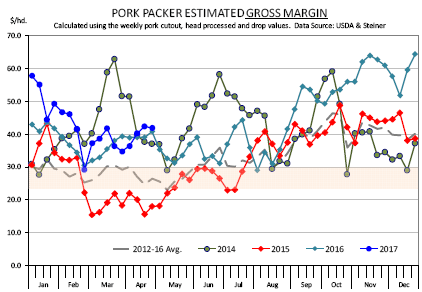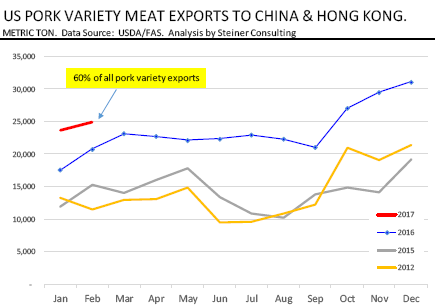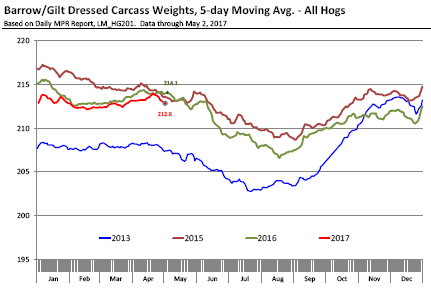



CME: Pork Packer Margins Remain in Good Shape
US - Pork packer margins remain in good shape and, as long as that is the case, the incentive will be to maximize slaughter schedules, reports Steiner Consulting Group, DLR Division, Inc.Hog slaughter this week could once again be above 2.3 million head despite some disruptions earlier in the week. This is good news for pork producers who are currently bringing 5-6 per cent more hogs to market than they did a year ago and need packers to run through the available supply with no delay. The following chart shows the estimated gross packer margin, which is basically the amount of revenue the packer derives from selling pork and hog by-products minus the cost of hogs themselves.

It is an imperfect measure, in part because it leaves out some revenue sources (such as exports) and also it does not account for the additional expenses in buying hogs with special attributes. Still, the measurement is consistent over time and we think it gives a good approximation of where the pork packer stands relative to previous years.
The shaded area in the chart is our best guess at this time as to what the packer needs to get from each hog in order to cover their operating costs. It is a squishy estimate that will vary from packer to packer and also will depend on capacity utilization, location, etc. Packing capacity is inelastic in the short term as it takes time and effort to bring new facilities into production.
As hog supplies have expanded rapidly in recent years (lower feed costs, good export demand) the packer has been able to realize robust margins, which in turn has provided the incentive to add new capacity. New plants already have entered production and more are scheduled to start operating later this year and in 2018.
One of the contributors to the gross packer margins is the value of pork by-products/variety meats. Often also referred to as the drop credit, it has increased in value in the last couple of years and thus added to the overall value of hogs for the packer. Exports are a major contributor to this value and exports to China/Hong Kong have over the years become increasingly important.
In February, US exports of pork variety meats to these two destinations were 24,932 MT, 20 per cent higher than a year ago and accounting for about 60 per cent of the overall exports of these products. Higher slaughter will generate more by-product tonnage so it is not a surprise that exports of pork variety meats have increased in the last couple of years.

What has been a positive surprise is the level of demand in these markets and the willingness of Chinese buyers to pay up to secure US products. The average value of pork variety meats going to China in February was $1,577/MT, 10 per cent higher than a year ago while the value of product going to Hong Kong was $2.050/MT, 24.5 per cent higher than last year.
With this background, one can understand the continued gains in drop credit values, which were last pegged at $19/head, about $1.1 (+6 per cent) higher than a year ago and 15 per cent higher than two years ago.
Futures market participants have been buoyed by hog cash prices that appear to have turned the corner and, as often is the case, started to move higher into the spring. There is a lot of speculation as to what the current spike in cattle/beef prices will do for pork demand this summer and fall.
Belly prices are substantially lower than where they were in the spring and, once again, should provide opportunities to promote bacon. The ratio of loins to ground beef and ribs to steaks is now near the low end of the range, which should offer the retailer good value for 4 July.









